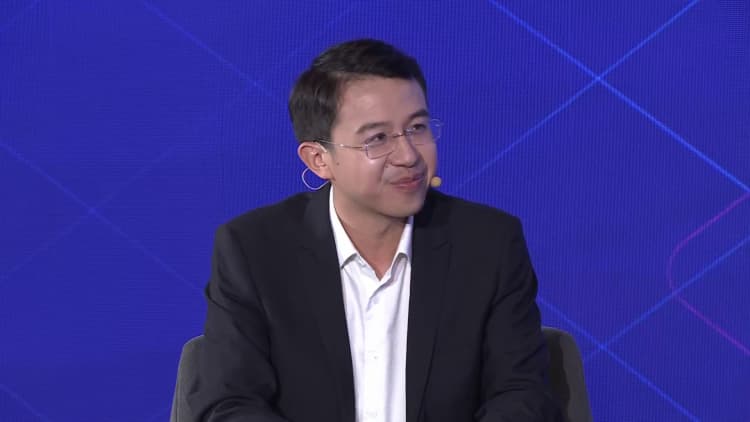People attend a launch ceremony of Inceptio’s autonomous driving system on March 10, 2021 in Shanghai, China.
Huanqiu.com | Visual China Group | Getty Images
BEIJING — China’s truck industry is finding more reasons to buy vehicles with assisted-driving technology.
It’s a critical step toward monetization in a nascent business that’s drawn many investor dollars, with relatively little to show for it so far.
One broad transformation is that the trucking industry in China is changing from one in which individual drivers dominated, to one with fleets holding the majority share, said Gui Lingfeng, principal at Kearney Strategy Consultants.
He pointed out that five years ago, fleet operators only had about 20% of the Chinese trucking market. Today it’s at 36%, and projected to reach 75% in 2025, he said.
The companies trying to sell trucks to fleet operators are including driver-assist tech as a way to make the vehicles more attractive, Gui said.

That early tech integration gives truck manufacturers an edge on the amount of data they can collect — for training autonomous driving algorithms, he said.
In addition, Chinese authorities require all newly manufactured trucks since 2022 to come with basic driver-assist tech for warning against forward collision and lane departure, Gui said.
Chinese driver-assist trucking startup Inceptio claims it already has more than 650 trucks operating in China — mostly for logistics customers — and covered more than 50 million kilometers (31 million miles) in commercial operations.
“The economy is getting tighter so the cost saving motivation is getting stronger not weaker that makes our customers more anxious to use our products
Inceptio develops the driver-assist tech system, and works with original equipment manufacturers (OEMs) for mass production.
“In terms of customers, there is a sort of a counter-cyclical effect,” Inceptio CEO Julian Ma said in an interview in late August. “The economy is getting tighter so the cost saving motivation is getting stronger, not weaker — that makes our customers more anxious to use our products.”
Express delivery customers
China’s logistics companies have seen enormous growth over the last several years, thanks to the rise of e-commerce. That’s led to price wars, amid slowing slowing economic growth.
Industry giant SF Holdings reported a 5.1% drop in operating revenue to 189 billion yuan ($25.97 billion) in the first three quarters of the year, including a 6.4% year-on-year decline in the third quarter alone.
But vehicle upgrade cycles can support continued truck sales.
Truck operators typically replace the vehicles every four to five years, Ma said. “In China there are around 7 million heavy duty trucks. Even if the market has zero growth, on the yearly basis there is between 1.2 to 1.5 million new sales.”
The startup claims its trucks cost about 5% less than traditional options, on top of safety and environmental benefits.
Already, an average of around 95% or more of a thousand-kilometer truck drive is handled by the computer, meaning the driver is mostly in standby mode, Ma said. “So the workload is much reduced.”
Ma said Inceptio’s focus over the next three years is on cost-sensitive customers, such as in logistics. He expects driver-assist features will dominate for the next few years, with 2028 the most optimistic scenario for the commercial deployment of fully driverless trucks.
Being able to remove drivers completely will result in the most cost savings for truck operators.
Platooning
Other startups are testing out different forms of driver-assist trucks in China.
Kargobot, backed by ride-hailing giant Didi, operates more than 100 autonomous-driving trucks between Tianjin, near Beijing, and the northern province of Inner Mongolia.
Many of those trucks operate via what’s called platooning — having a human driver sit in the front vehicle and having two or three trucks follow behind in fully self-driving mode, with no human staffer inside.
Kargobot CEO Junqing Wei envisions that in the next decade or two, a network of hubs on the edge of cities, connected by highways on which self-driving trucks transport products. That’s according to his remarks in October at CNBC’s East Tech West conference in the Nansha district of Guangzhou, China.
Waiting to prove an inflection point
Analysts at Yole Intelligence are closely watching whether robotruck companies can make good on production and delivery goals set for the next two years.
It’s a $2 trillion market, of which China accounts for about $650 billion to $750 billion and the U.S. slightly more than that, said Hugo Antoine, technology and market analyst, computing and software, at Yole Intelligence, which is part of Yole Group.
“This is the reason why we have many investors invest in this market,” he said. “Because if you have one percent or two percent of this market it is huge.”
However, it remains unclear how quickly regulators will allow fully driverless trucks on most roads, even if operators want to buy them.
“Even when the industry is technically ready, I think in any part of this world the transportation regulator will take another year or even two years, to validate the data and have their own testing before they can issue the driverless license,” Inceptio’s Ma said.





